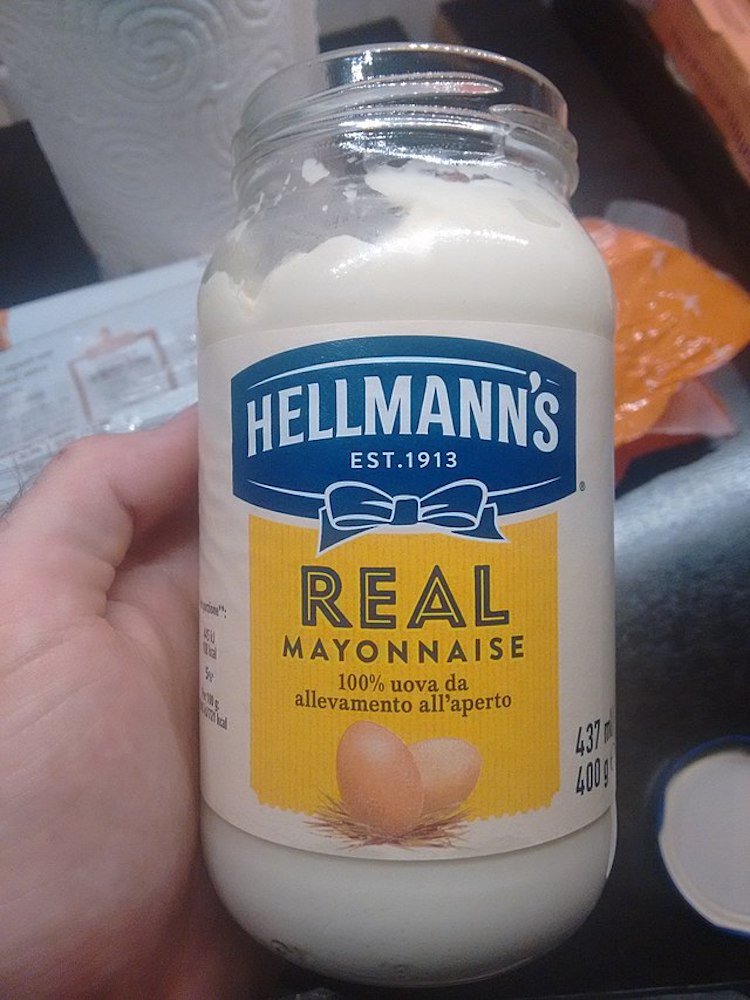People Really Used To Love Mayonnaise
In the pre-Depression era, casseroles were a perfect way to use up supper leftovers for another night’s meal. Throw everything into a deep-dish pan, cover the top with leftover mashed potatoes and/or cheese, and bake until golden brown and hot throughout.
But the Great Depression brought new challenges for feeding families, especially large ones. Leftovers were virtually unheard of during this time of great poverty, as there was very little food to go around. Inexpensive mayonnaise became a popular way to stretch food further, often into multiple meals. Even today, savvy cooks and frugal families use mayonnaise in this fashion, as well as honoring its original purpose as a sandwich condiment.

Sir Hellmann, King Of Mayonnaise
Mayonnaise was introduced to Americans in New York City in 1905 by Prussian immigrant Richard Hellmann. He developed mayonnaise as a way to draw customers into his delicatessen. When it became very popular, he branched out to bulk sales, and then later built his own factory.
In 1927, Best Foods introduced its own mayonnaise on the west coast. Both Best and Hellmann’s brands cornered a commanding market on separate sides of the country. When Hellmann wanted to retire, he sold his brand to Best (then Potsum) Foods, his biggest competitor. It made better financial sense for Best Foods to retain the divided market rather than risk the loss of customers. An interesting play on words was coined in 1987’s marketing slogan, enlisting both label names: “Bring Out The Hellmann’s, And Bring Out The Best.”

Black Thursday And The Great Depression
The October 1929 stock market crash, known as Black Thursday, was a major precursor to The Great Depression. The worst economic downturn in history left people in great poverty, and an instinctual human panic response increased food shortages.
Meatless meals became commonplace, and thrifty new ways to make meals stretch were sought by families with mouths to feed. Mayonnaise, which mostly takes on the flavor of whatever it’s mixed into, was one inexpensive way to stretch pasta, meat, or vegetables.
Rationing, Frugality, And Excess
As people finally began getting back on their feet after the Depression and began seeing a brighter future, the Second World War commenced, along with rationing. Sensible families dug out their meal-stretching recipes once again. Their children, starting families of their own, followed suit. The culture of frugality in which they were raised meant resourcefulness and thriftiness were still considered virtues.
American families of the Atomic age, however, were tired of war rationing. And when it finally ended, people wanted to stop feeling guilty and celebrate in excess. This ushered in an era of parties that were all about showing off culinary talents on food-laden tables.

Home Economics And The Aspic
In modern times, if someone mentions gelatin, the most likely image that comes to mind is some version of a sweet dessert. But in 1950s America, gelatin was popularized in the form of a savory dish called an aspic. Aspics showcase suspended filling and can be allowed to set in molds to create different shapes.
Aspics are historically made with gelatin that’s been created from, or enhanced by meat broth. Meat has a natural gelatin, and when meat stock cools, it congeals. Clarified by egg whites, the stock is then flavored and filled before the congealing process is completed.
With the popularity of home economics classes for young women, recipes for 1950s housewives featured aspics of various degrees of difficulty. Shaped molds were specifically sold for this reason, often themed to the ingredients. The finished products were quite often topped with dollops of mayonnaise and sliced vegetables as a garnish.
If gelatinous, wiggly masses filled with meat and sliced vegetables are your thing, be sure to decorate them well to properly show off your talents. And don’t forget the mayo!

